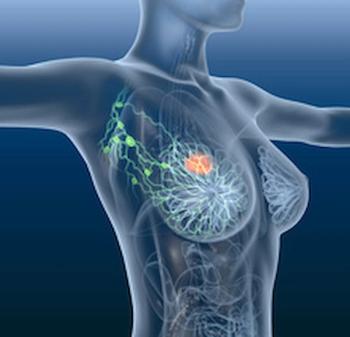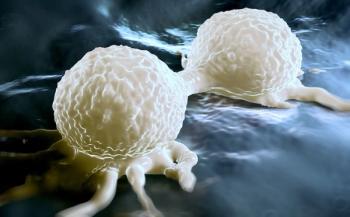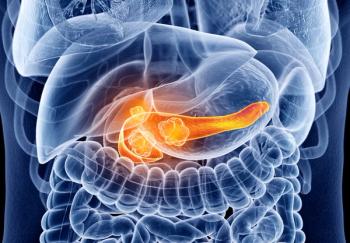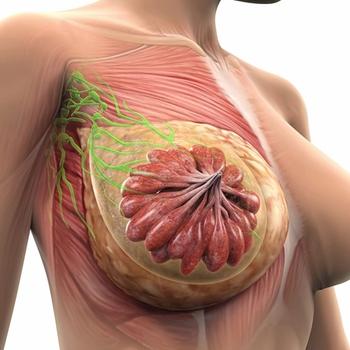
Better PFS Noted in Desmoid Tumors Treated With Nirogacestat Vs Placebo
A phase 3 study presented at 2022 ESMO showed progression-free survival benefit of nirogacestat over placebo for patients with progressive desmoid tumors.
Findings from the phase 3 DeFi trial (NCT03785964) that were presented at the
At a median follow-up of 19.2 months with nirogacestat (n = 70) and 10.9 months with placebo (n = 72), the median progression-free survival (PFS) was not estimable (NE; 95% CI, NE-NE) and was 15.1 months (95% CI, 8.4-NE) with placebo (HR, 0.29; 95% CI, 0.15-0.55; P < .001).
“Nirogacestat demonstrated rapid, sustained, and statistically significant improvements in all primary and secondary efficacy end points,” lead study author Bernd Kasper, MD, PhD, a professor at the Universitätsmedizin Mannheim in Germany, said.
Desmoid tumors are rare, locally aggressive, invasive soft tissue tumors that are difficult to manage due to heterogeneous presentation, disease course, and absence of approved therapies. Nirogacestat is an investigational, oral, selective, small molecule gamma secretase inhibitor that has demonstrated efficacy in desmoid tumors in phase 1 and 2 trials. The Notch pathway, which is active in desmoid tumors, is blocked by gamma secretase inhibition, providing mechanistic rationale for the agent in this population.
DeFi is a global, randomized, double-blind, placebo-controlled phase 3 trial evaluating the activity and safety of nirogacestat in patients with progressive desmoid tumors. Eligible patients had histologically confirmed desmoid tumors with progressive disease (PD) per RECIST1.1 criteria. Patients either had to be previously untreated and unfit for surgery or have recurrent or refractory disease following 1 line of therapy.
Patients were randomly assigned 1:1 to 150 mg of nirogacestat twice daily or matched placebo in 28-day cycles until radiographic disease progression, at which point patients in the placebo arm could receive open-label nirogacestat. The primary end point was PFS, with secondary end points of objective response rate (ORR), QOL, and patient-reported outcomes (PROs) for pain, symptom burden, and physical and role function.
The cutoff for the primary analysis was April 7, 2022.
The ORR assessed by blinded independent central review was more than five times higher with nirogacestat compared with placebo, at 41% (n = 29; 95% CI, 30.2%-54.5%) vs 8% (n = 6; 95% CI, 3.1%-17.3%), respectively (P < .001).
In the nirogacestat arm, best overall response consisted of 5 (7%) complete responses (CRs), 24 (34%) partial responses (PRs), and 35 (50%) cases of stable disease (SD). One patient developed PD, and 4 (6%) patients were not evaluable. In the placebo arm, best overall response included 6 (8%) PRs and 55 (76%) cases of SD. There were no CRs. Ten (14%) patients had PD, and one patient was not evaluable.
The median time to response with nirogacestat was 5.6 months (range, 2.6-19.4) vs 11.1 months for placebo (range, 2.8-16.4). The estimated Kaplan-Meier duration of objective response was not estimable in both arms.
Regarding PROs, nirogacestat led to a significant reduction in pain severity at cycle 10 of treatment compared with placebo, with least squares mean change from baseline of –1.5 vs –0.04, respectively (difference, –1.5; P < .001).
The median duration of nirogacestat and placebo exposure was 20.6 months (range, 0.3-33.6) and 11.4 months (range, 0.2-32.5), respectively. The median dose intensity was 288.3 mg per day (range, 169-300) with nirogacestat and 300.0 mg per day with placebo (range, 239-300). Dose reductions were common in the nirogacestat arm at 42% (n = 29), but few patients required discontinuation (n = 14; 20%). No dose reductions occurred in the placebo arm, and only one discontinuation was reported.
Regarding safety, Kasper noted that 95% of treatment-emergent adverse effects (TEAEs) were grade 1 or 2 and presented in most patients during cycle 1 of therapy. The most common grade 3 or greater TEAEs in the nirogacestat and placebo arms, respectively, included diarrhea (16% vs 1%), maculopapular rash (6% vs 0%), stomatitis (4% vs 0%), fatigue (3% vs 0%), hypophosphatemia (3% vs 0%), and nausea (1% vs 0%).
There were no TEAEs that led to death in the nirogacestat arm and one fatality due to sepsis in the placebo arm.
“DeFi represents the largest and most rigorous randomized controlled trial conducted to date in desmoid tumors and is also the first phase 3, randomized, controlled trial to demonstrate clinical benefit with a gamma secretase inhibitor in any indication. [As such,] nirogacestat has the potential to become the standard of care for patients with desmoid tumors requiring systemic treatment,” Kasper concluded.
Reference
Kasper B, Ratan R, Alcindor T, et al. DeFi: a phase 3, randomized controlled trial of nirogacestat versus placebo for progressing desmoid tumors (DT). Ann Oncol. 2022;33(suppl 7):LBA2. doi:10.1016/annonc/annonc1089
Newsletter
Stay up to date on recent advances in the multidisciplinary approach to cancer.

















































































